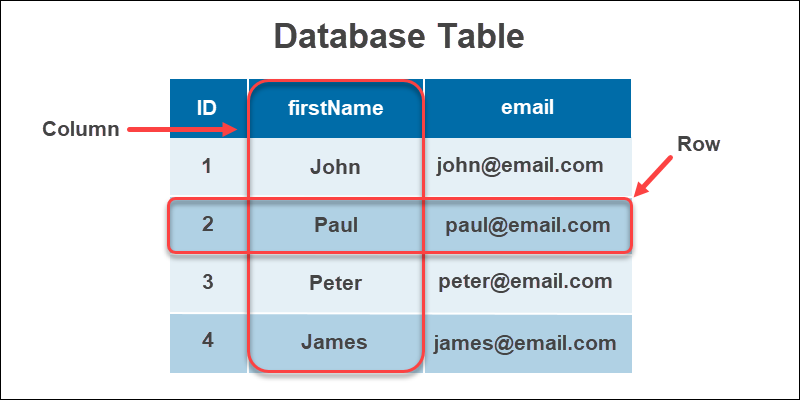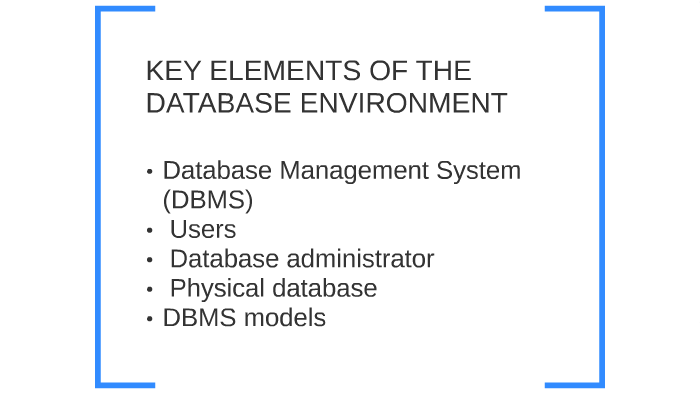Elements of a Database-What parts of a database are there? This article focuses primarily on the database items. In terms of database design, a few ideas merit discussion within the parameters of the database. As you deal with data and databases, you’ll observe how business information and database creation transform into database elements. The article’s purpose is to give you a quick overview of the fundamental database pieces and a basic idea of what makes up a database.
Several topics are converse in the following sections. These topics include in Elements of a Database:

- The database schema
- Schema objects
- Indexes
- Tables
- Fields and columns
- Records and rows
- Keys
- Relationships
- Data types
Database Schema
A database’s schema is just a collection of related items. As was previously said, linked items have relationships with one another within a schema. A schema has a single owner who has access to change any object’s structure. Despite being tied to a user account stored in the database, a schema does not represent a specific individual.
The three models linked to a schema are as follows:
- The fundamental database model is known as the conceptual model or logical model. It deals with the organizational structures that specify database structures like tables and constraints.
- The internal model, also known as the physical model, deals with the physical storage of the database and access to the data, including the use of indexes to speed up data access and data storage in tables. The internal model isolates the data model from the technical specifications of the operating system and hardware.
- The external model, often known as the application interface, deals with how users can access the schema through a data input form. Can establish relationships between the user application and the data model.
Table
The main physical storage structure for data in a database is a table. A table is typically referred to when a user consults the database to find the needed data. A database may have several tables. Hence there may be a relationship between them. Tables require physical storage on the host machine for the database since they store data.
There are four common types of tables:
- Most data in a database is set aside in data tables.
- Join tables use to establish a connection between two tables that wouldn’t otherwise connect.
- Tables with subsets of data are called subset tables.
- Validation tables—code tables—are used to check the accuracy of data entered into other database tables.
The user-required data is set aside in tables for easy access. Additional restrictions that limit the information that can add to a table may be attached. Eventually, a database table creates from an entity from the business model.
Columns
A column, often known as a field, is a particular type of data found in a table. What an attribute is to an entity, a column is to a table. In other words, entities become tables, and facts become columns when a business model transforms into a database. A minor logical storage structure in a database, a column, represents one associated component of a table. A data type assigns to each column in a table. What kinds of values enter into a column depends on the given data type. For example, a queue is a vertical component in a table that includes values for each row of data that belongs to that column when viewing a table.

Rows
The collections of the columns in the table corresponding to one instance are known as rows of data. Simply put, a table’s rows of data are its records. For example, when the book titles table fills with data, it will include 25,000 documents, or rows of information, if the shop deals with 25,000 different book titles. Naturally, as new and removed book titles add to the table, the number of rows will fluctuate.
Data Types
The kind of data that can keep in a database column determine by its data type.
Even though there are several data kinds, the following three are the ones that are most frequently used:
- Alphanumeric
- Numeric
- Date and time
It can store characters, integers, special characters, and almost any other combination in alphanumeric data types. An alphanumeric field treats a numeric value stored there as a character rather than a number. Put another way, you shouldn’t try executing arithmetic operations on numerical values stored in fields with alphanumeric characters. The book will go into greater detail on design strategies like these. The only sorts of data that can store are numerical values. Depending on the relational database management systems (RDBMS), date and time values might vary considerably. Hence date and time data types are employed to store them.
Keys
Keys regulate the integrity of the data contained in a database. A key is a column value database used to either establish a relationship with another table or uniquely identify a row of data in the table. Although it may link to numerous columns, a key typically correlates with one column in a table. Keys come in two varieties: primary and foreign.

Primary Keys
A primary key is the set of one or more column values in a table that distinguishes each row of data. Commonly, similar tables join using primary keys. You can use a primary key to prevent the insertion of duplicate records into a table, even if it doesn’t have any children’s tables. A primary key candidate might be a worker’s social security number, for instance, because each SSN is distinct.
Foreign Keys
A foreign key is the collection of one or more column values in a table that relates to a primary key in another table. Child tables contain the definitions of foreign keys. A vital foreign guarantee that a created parent records before a child record, on the other hand, is crucial for foreign security that the child records removes before the parent records.
Relationships
Most tables in databases are related to one another and are separated into several sections. Relationships are created in most contemporary databases using primary and foreign keys, such as relational databases. The procedure known as normalization reduces data redundancy in a relational database and covers it in detail.
The following three types of table relationships can be derived in Elements of a Database:
- One record in one table has a one-to-one relationship with only one record in another table.
- One-to-many Relationships One entry in one table may be associated with numerous records in another.
- One or more records in one table may be associated with one or more in another table and vice versa. It is known as a many-to-many relationship.
Conclusion
The purpose of this essay was to provide a brief overview of basic database parts to provide a fundamental grasp of the components contained in a database. Even though it might not seem like much cover, you have now had the opportunity to learn about the essential subjects related to working with databases. Elements of a Database All the vocabulary above and ideas, including schemas, tables, columns, rows, and keys, will be consistently present as you interact with databases.
Also read: What are the Examples of Database use in 2022








GIPHY App Key not set. Please check settings